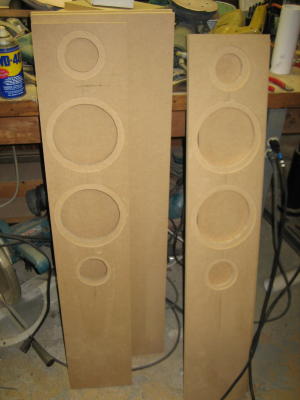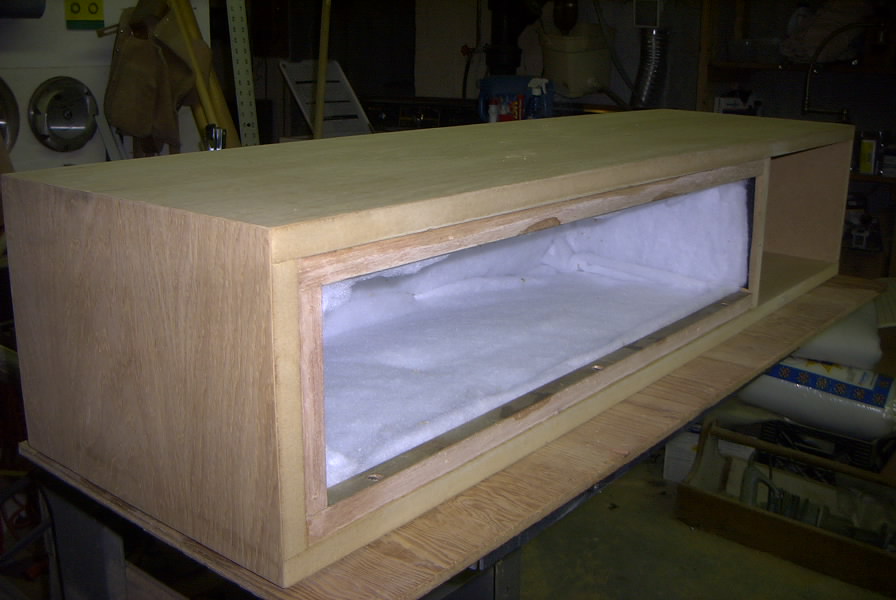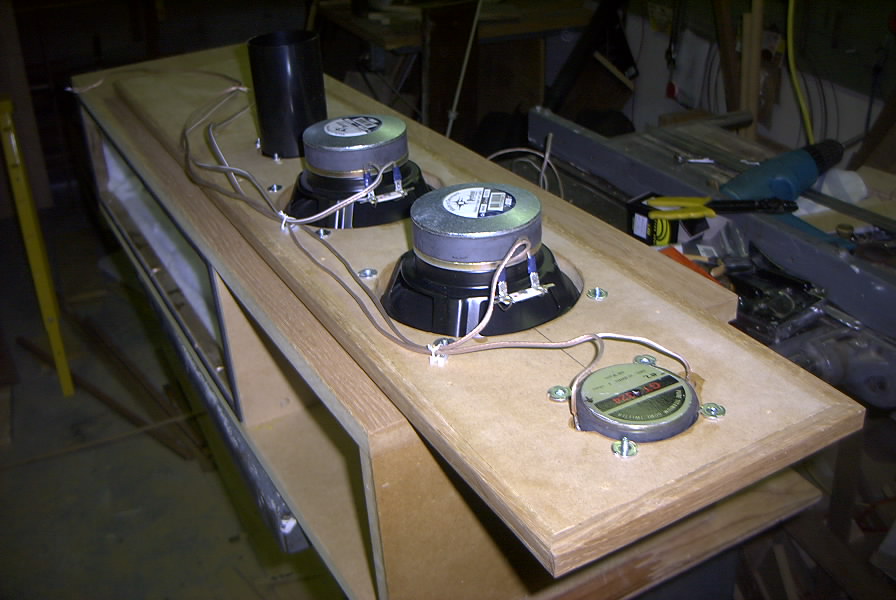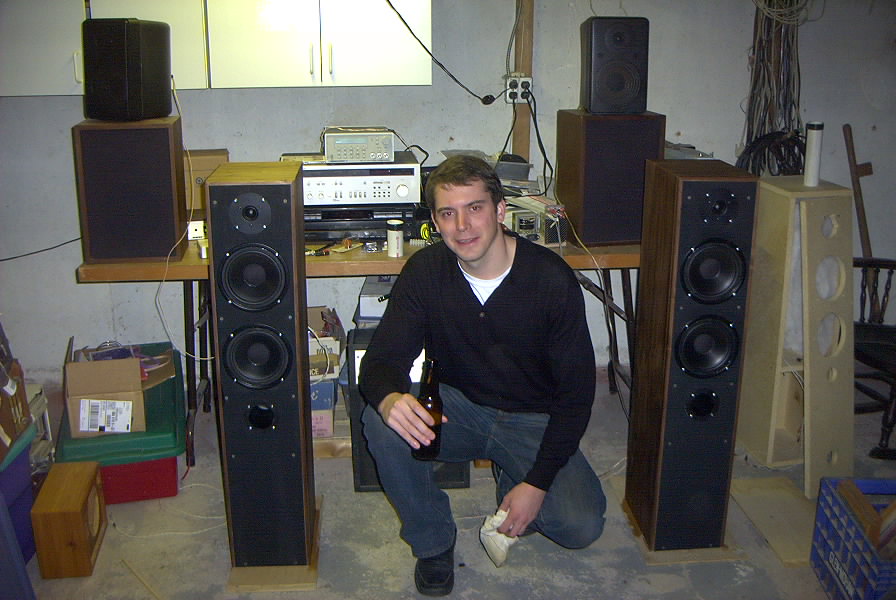Martin and
Dave's Speaker Page
A Chronicle
of Speaker Design
Martin and I are EEs that worked together at Zoll
Medical. I have since moved on to a startup. In the year or so that we
worked together we discovered a connection in the desire to create.
The subject of home audio came up and I have dabbled in speaker design
and building in the past. My current speakers aren't very current:
home-brewed Bose 901
MKI clones, built in late seventies. They continue to perform well to
this
day in my living room and in my basement. Martin's speakers are small
monitors whose foam surrounds have long since turned to dust. It was
time for us both to upgrade.
We looked at commercial tower speakers and liked the fact that they
were close to proper height for listening without requiring stands,
that they had a small footprint, and had nice clean sound. The clean
sound is what appeals to us. No screeching highs, no thumping bass,
just clean, flat, low distortion sound. We both like all kinds of
music. Me mostly singer-songwriter stuff, seventies rock and roll, some
modern. I also listen to TV with these speakers so maybe a sub-woofer
is in the future... We considered building sub's into the towers like
Cambridge Soundworks Newton's, but the enclosures would need to get
real big. So a separate sub tucked into a corner someday...
So one rainy Saturday in the '05 summer I looked around the basement,
and saw some old bookshelf speakers I had built ages ago, and some
particle board scraps, and went to town. With a 'plan' drawn on the
back of a receipt. I built the proto box. I scavenged two 6.5" Pioneer
woofers and a teeny Pioneer tweeter out of the bookshelfs. In there I
also found some crossover parts, terminals, and polyester batting.
Within a few hours the first proto box was built and I was listening to
it. It was a definite case of 'ready, fire, aim' (build first,
design later). So I built it and set it up against the Bose 901s, some
old EPI 8" bookshelfs, and started listening. It didn't sound too bad!
The crossover was a first order (inductor for the woofer and cap for
the
tweeter). I invited Martin over, we experimented with positioning a
baffle inside in order to vary the volume, and added a port tube of 1
1/2" PVC. We experimented with different ports, and decided that with
decent drivers, decent materials, crossover, design, and
construction, we could build decent sounding speakers.

The first speakers would be two way towers. Dual 6.5"
woofers, soft dome tweeters, 100W+ capability, even though we'd be
running them at conservative apartment and suburban listening
levels. We perused many speaker builder's web sites, and found
some good design ideas.
I found drivers on Ebay at good prices. Peerless
6.5" woofers for $10 apiece. I also found some 100W titanium dome
tweeters (so much for soft domes) for $20 a pair. My approach on most
purchases is to consider carefully all the options and possibilities,
weigh them carefully, then go for the cheapest! In the case of these
speakers, I mounted them in the proto box, re-twaked the crossover, and
was very pleased with the results. Martin wasn't convinced that my
'ebay
deal' drivers were the best, but when I pointed out that I could get
another 4 Peerless woofers for under $50, he couldn't resist. He
bought a pair of proper Vifa silk dome tweeters from PE for $50 a
pair. It was
time
to build some real speakers.
-- Dave
11/15/05
Here is the first pair of speakers we built. The tweeters are
Martin's Vifa's and the woofers Peerless. Construction of the rear
enclosure is 3/4" MDF glued together. The corners are caulked and the
insides lined with two layers of roofing felt plus about 1" of
polyester batting. The front baffles are screwed into hardwood
cleats. For now we wanted to be able to play with the front baffles
changing drivers, positions and porting. We'll probably stick with this
approach forever and use gasketing to seal the front properly.

We have a plan for finishing them, but that's coming.....
Here is one of the passive 6db crossovers, front and rear view.
Components from parts express. The European style terminal block made
the wiring and the connections to the speakers easy. Crossover
frequency is 2.4KHz. The l-pads are to allow to adjust the tweeter
level to match the woofers.
With two 8 ohm woofers in parallel, the speaker's impedance at low
frequencies is 4 ohms, but a reasonable amplifier can handle this load.
Just don't use two speakers at the same time.


Dave, 11/18/05
We began the contraction of the second pair on 12/1/05. With most of
the dimensions established, cutting the parts went quickly. The
internal baffle is being used as a spacer to keep the center from
sagging while the glue dries. The joints are only glued, no screws used
so far except the removable front baffles. We could have gone either
way on screws: the veneer will cover screw heads, but Titebond glue is
very strong and we think quite
adequate.

On the front baffles, we recessed all the speakers and the port tube
flanges. The baffles don't yet have their 3/8" hardwood strips on the
sides and tops to match the
veneer.

The
enclosures are lined with one layer of roofing felt followed by about
3/4" of polyester batting for dampening. Since the boxes are a bit of
an experiment, we wanted to be able to remove the baffles in the
future. So we used wooden cleats on the insides to screw the baffles
into. We didn't want to screw directly into the MDF since it would
eventually weaken. The cleats are recessed 1/16" and a 1/18" rubber
grommet is installed on the cleats to seal the enclosures. Then the
front baffles are installed with 1 5/8" screws. This is the first pair,
done in white oak veneer.

Drivers
and ports mounted on the baffles and wired up. The drivers were
gasketed with speaker gasket tape. Note the 3/8" strips of solid white
oak trim around the baffle. This pair has Titanium dome tweeters,
not the VIFAs.

The second pair veneered in Walnut and stained with Minwax Natural. We
think these look terrific with their flat black baffles and bookmatched
veneer.

Martin celebrating the completion of the second pair. We were very
pleased with both the sound and the look.

Overall
dimensions: 42"H x 8.5" W x 12 3/4" D
Main chamber:
7.5" W x 27"H x 11"D = 1.3 cu ft less the battens, batting and speakers
is about 1.1 cuFt.
Parts list for two speakers:
Qty
|
Description
|
Part number
|
$Total
|
Source
|
|
Cabinets
|
|
|
|
5
|
2' x 4' sheets
3/4" MDF
|
|
$25.00
|
Home Depot
|
1
|
2' x 8' sheet
veneer, wood selection to taste
|
|
40.00
|
Rockler
|
1
|
3/4 x 4" x 5'
hardwood |
|
10.00
|
Rockler
|
1
|
about 12' of
3/4" x 3/4" hardwood cleats (scrap) |
|
|
|
24
|
#8-32 T-nuts
(Speakers)
|
|
6.00
|
Home Depot
|
8
|
#8-32 Hex nuts
(Ports)
|
|
1.00
|
Home Depot
|
64
|
#8x32, 1" RH
screws (Black preferred)
|
|
5.00
|
Home Depot
|
30
|
1 5/8" drywall
screws, black
|
|
3.00
|
Home Depot
|
|
8' 30# roofing
felt
|
|
|
Home Depot
|
1
|
Roll 1"
polyester batting
|
|
4.00
|
Fabric store
|
|
Titebond glue,
flat black spray paint,
Minwax Natural stain, polyurethane,
sandpaper
|
|
|
Home Depot
|
|
Subtotal
|
|
$94.00
|
|
|
Speakers
|
|
|
|
4
|
Peerless 6.5"
woofers. (Note 1)
|
|
60.00
|
Ebay
|
2
|
Vifa D27TG-05 silk dome tweeters
|
264-524
|
42.90
|
Parts Express. |
2
|
2.5" adjustable
port tubes
|
260-386
|
4.10
|
Parts Express. |
1
|
Speaker
Gasketing Tape
|
260-540
|
4.23
|
Parts Express. |
25'
|
16 Ga speaker
wire
|
|
2.00 |
Radio Shack |
8
|
3/16" female
disconnects (for woofers) |
095-287
|
3.25 |
Parts Express. |
|
Subtotal
|
|
116.48
|
|
|
Crossovers
|
|
|
|
2
|
Inductor,
.27mH 18GA
|
255-216
|
4.88
|
Parts Express. |
2
|
Cap, 8.2uF
polypro., Dayton
|
027-426
|
8.50
|
Parts Express. |
2
|
L-Pad, 8 ohm 50W
mono,
|
260-252
|
10.50
|
Parts Express. |
2
|
Dual banana
plug, red and black
|
090-471
|
3.50
|
Parts Express. |
2
|
European style
screw terminal, 8 position
|
|
3.00
|
Radio Shack |
2
|
5" square
plastic or sheet metal scraps
|
|
|
|
|
Subtotal
|
|
26.38
|
|
|
Total
|
|
236.86
|
|
Note 1:
These were surplus OEM drivers manufactured by Peerless for NHT. Other
6.5" drivers can be used and may need a different cabinet volume. This
can be accommodated in these cabinets by adjusting the internal baffle
up or down and/or adjusting the port length and diameter.
Drivers
Our criteria for driver selection was fairly simple. 2 woofers and one
tweeter that could handle 100W RMS each, flat response and low
distortion at normal listening levels. We wanted overlap on the woofer
and tweeter response curves so a simple 1st or 2nd order crossover
design wouldn't be fighting the speaker response curves. This is hard
to do with 8" and larger woofers but very achievable on 6.5" woofers.
We wanted high frequency response of the woofers to be 5-6KHz. And the
low frequency response of the tweeter to be about 2KHz, for a 2.5-3 KHz
crossover cutoff. You generally don't want the crossover to be in the
midrange area between 500Hz and 2KHz since that's where the ear is most
sensitive. The Vifas are spec'ed from 2.5 to 30KHz but their response
plots look good down to about 1KHz (Vifa
D27TG-05 Specs). The Peerless are spec'ed about 50Hz to 6KHz.
We chose the crossover to be 2.5 KHz for both the 1 and 2 pole designs.
We weren't too concerned about driver sensitivity. Using two woofers in
parallel is like having another 3db of low and midrange sensitivity.
Despite this, the tweeter sensitivity would still be a bit higher and
so a pad (attenuator) would be needed to compensate. The Vifas are 6
ohm speakers but an L-pad set to anything but MAX will
tend to make them look like 8 ohms to the crossover. L-pads seem to be
taboo among audiophiles, but these sound fine and are rated 50W. Since
these speakers are one big experiment, having a tweak on the tweeter is
a good thing.
We could not
find data on the Peerless 831773 surplus woofers, so we
just measured their Thiele-Small parameters. They look similar to
Peerless 833599's except the magnet is a bit smaller diameter
than the 833599. (Peerless 833599 Specs). These are
polypropylene cone, rubber surround, steel basket speakers. A goal for
the woofer was no foam surrounds since they tend to deteriorate over
time. Martin has had them crumble on him. My Bose 901's have the
original CTS drivers with rubber treated paper surrounds and are in
great shape after 30 years. So rubber it is.
All in all we're
real happy with the sound of the drivers and 1st order crossovers. But
I have a nagging feeling that 2nd order may sound cleaner, possibly
flatter. Next project....
Now
that I have these great new speakers...
The latest here in nerd-land is that with these efficient and clean
speakers I can now hear every little flaw in the homebrewed ca. 1978
amplifier and 1990 preamp I use. With Bose 901's mounted at
ceiling level the amp never ran at less than a few watts so low level
distortion was not an issue. I built up a
better bias circuit to clean up crossover distortion. It
allows the amplifier quiescient current to be adjusted and eliminates
the crossover distortion.
Then I found that the cheesy 6'
RCA cables I was using picked up 60Hz from the rest of the
system. The amp runs at full gain always so it's input is super
sensitive to hum which the speakers faithfully reproduce. The Bose's
were >10dB down at 60Hz (with the equalizer making up the
difference) so no problem. I suspected crummy shielding. I went thru
all the cables I had until I found quieter ones. I can't bring
myself to buy Monster RCA cables so I bought proper plugs and will
build up cables using RG58. Don't get me wrong, crappy cables work
perfectly well for line level stuff (CD output, etc.), but for low
level (phono and amp input) good shielding is important.
The preamp chip I use is the TDA7318
which doesn't have loudness control. With the Boso's you would just set
the equalizer to adjust the bass and treble boost so it sounds good.
The new speakers really needs loudness compensation. So I ordered a new
TDA7313 preamp chip with loudness and will add it in to the hardware
and software when it arrives.
The CD player always puts out a bunch
more volume than the rest of the components. Now that I'm obsessed
about loudness it bothers me. So I wired up a set of cables with fixed
1/4 attenuators for the CD output. All CD players I've owned seem to
do this. I wonder why.
While I was in the preamp I re-did the
IR remote software. It worked, but only with an ancient universal
remote. I got a new 8-in-1 do-all remote at Circuit City ($20) and
updated the codes in the preamp to look like a more modern Sony
reciever. Now we can be proper couch potatoes with one remote doing it
all.
The processor controlling the preamp
is an old 68hc11 wire-wrapped with lots of support chips (RAMs, ROM,
FPGA) to drive the graphics LCD display. I'm prototyping up a new
single chip Atmel processor with a nicer looking and smaller, brighter,
smart LCD (no controller needed) just for fun. If the old C code
ports well I may put it in the preamp. Hey it's going on 15 years old
and needs to be played with.
Photo
Gallery
Bi-Amp?
The Lab
Last Updated:
Jan 28, 2006





